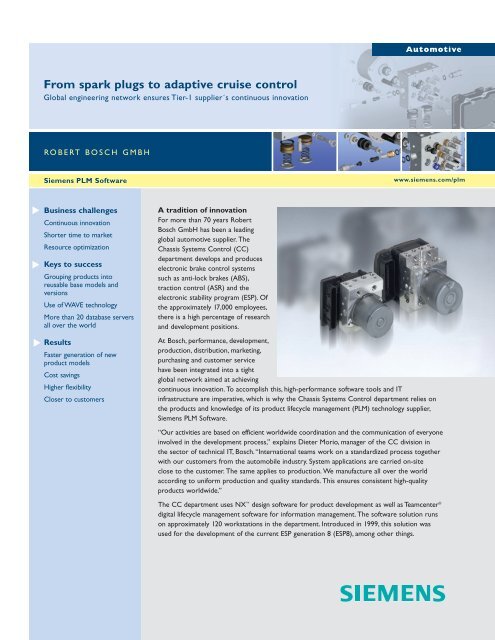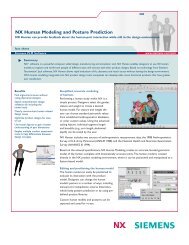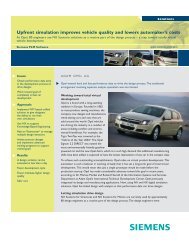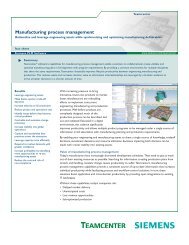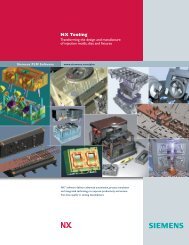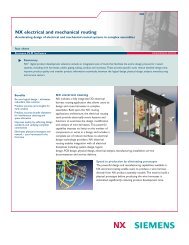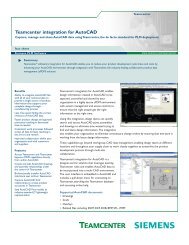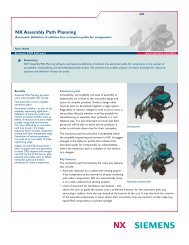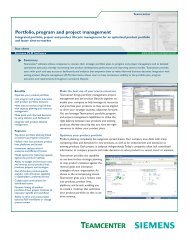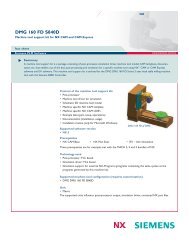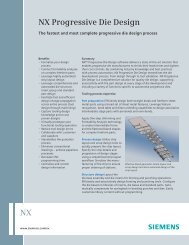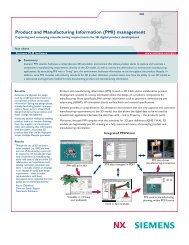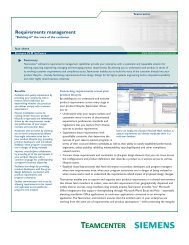Robert Bosch GmbH - Siemens PLM Software
Robert Bosch GmbH - Siemens PLM Software
Robert Bosch GmbH - Siemens PLM Software
You also want an ePaper? Increase the reach of your titles
YUMPU automatically turns print PDFs into web optimized ePapers that Google loves.
Automotive<br />
From spark plugs to adaptive cruise control<br />
Global engineering network ensures Tier-1 supplier´s continuous innovation<br />
RO B E RT B O S C H G M B H<br />
<strong>Siemens</strong> <strong>PLM</strong> <strong>Software</strong><br />
www.siemens.com/plm<br />
Business challenges<br />
Continuous innovation<br />
Shorter time to market<br />
Resource optimization<br />
Keys to success<br />
Grouping products into<br />
reusable base models and<br />
versions<br />
Use of WAVE technology<br />
More than 20 database servers<br />
all over the world<br />
Results<br />
Faster generation of new<br />
product models<br />
Cost savings<br />
Higher flexibility<br />
Closer to customers<br />
A tradition of innovation<br />
For more than 70 years <strong>Robert</strong><br />
<strong>Bosch</strong> <strong>GmbH</strong> has been a leading<br />
global automotive supplier. The<br />
Chassis Systems Control (CC)<br />
department develops and produces<br />
electronic brake control systems<br />
such as anti-lock brakes (ABS),<br />
traction control (ASR) and the<br />
electronic stability program (ESP). Of<br />
the approximately 17,000 employees,<br />
there is a high percentage of research<br />
and development positions.<br />
At <strong>Bosch</strong>, performance, development,<br />
production, distribution, marketing,<br />
purchasing and customer service<br />
have been integrated into a tight<br />
global network aimed at achieving<br />
continuous innovation. To accomplish this, high-performance software tools and IT<br />
infrastructure are imperative, which is why the Chassis Systems Control department relies on<br />
the products and knowledge of its product lifecycle management (<strong>PLM</strong>) technology supplier,<br />
<strong>Siemens</strong> <strong>PLM</strong> <strong>Software</strong>.<br />
“Our activities are based on efficient worldwide coordination and the communication of everyone<br />
involved in the development process,” explains Dieter Morio, manager of the CC division in<br />
the sector of technical IT, <strong>Bosch</strong>.“International teams work on a standardized process together<br />
with our customers from the automobile industry. System applications are carried on-site<br />
close to the customer. The same applies to production. We manufacture all over the world<br />
according to uniform production and quality standards. This ensures consistent high-quality<br />
products worldwide.”<br />
The CC department uses NX design software for product development as well as Teamcenter ®<br />
digital lifecycle management software for information management. The software solution runs<br />
on approximately 120 workstations in the department. Introduced in 1999, this solution was<br />
used for the development of the current ESP generation 8 (ESP8), among other things.
Automotive<br />
Solutions/Services<br />
NX<br />
Teamcenter<br />
Client’s primary business<br />
<strong>Robert</strong> <strong>Bosch</strong> <strong>GmbH</strong> is a leading<br />
global automotive supplier.<br />
www.bosch.com<br />
Client location<br />
Stuttgart<br />
Germany<br />
“We have come to recognize<br />
the multi-site solution of<br />
Teamcenter as a very good,<br />
high-performance tool. We<br />
value it as the best system<br />
available on the market for<br />
us.”<br />
Michael Schlitzkus<br />
Engineering Department<br />
<strong>Bosch</strong> C.C.<br />
Global data pool<br />
The current ESP was defined as modular from the beginning. Its purpose was to ensure that all basic<br />
models for the American, Asian and European markets could be re-used with minimal effort, to<br />
position new products on the market as quickly as possible. To achieve this, the CC department,<br />
together with the IT engineering support of <strong>Bosch</strong>, established a global data pool for worldwide<br />
development based on Teamcenter. From this collaboration, a software environment was developed<br />
that performs like a system.<br />
A worldwide development team was formed to first define the base model and drawings for the ESP8<br />
series. These were to be independently usable by each customer, from a motorcycle to a light-duty<br />
truck. Customer-specific requirements were supplemented during the distribution of base models to<br />
the individual markets. The uniform CAD base models with associated drawing sets for the ESP8<br />
series were defined using NX. For example, they showed that a pump housing made of aluminum has<br />
different holes to fit different components. In this way it is possible, in theory, to make about 2,500<br />
versions from six raw parts and 24 base parts. Since the basic structure of the ESP8 series was defined<br />
using NX WAVE technology, variations made with the customized additions and adjustments are<br />
always associatively linked, through so-called WAVE links, with the respective base model.<br />
Based on this, efforts to generate new base models as well as the corresponding drawings have been<br />
significantly reduced. Generation of versions or their modifications can also be done faster. A database<br />
with worldwide access to current data was imperative for product development, according to the<br />
goal of implementing international simultaneous engineering.<br />
Worldwide simultaneous engineering<br />
The department established a <strong>PLM</strong> concept using Teamcenter with separate servers for individual<br />
regions and different time zones (where it worked with replicated data), to achieve optimum loading<br />
times at all locations. Data adjustments are required to more than 20 worldwide databases, most of<br />
which are Windows-based. The data adjustments are made at night for regionally limited simultaneous<br />
engineering environments. As night varies globally, <strong>Bosch</strong> decided to perform the automatic<br />
synchronization at the end of the working day of the affected time zone for a maximum delay of 24<br />
hours. Furthermore, synchronization can be activated manually at any time. <strong>Bosch</strong> is also considering<br />
synchronization when a component is saved.<br />
<strong>Bosch</strong> CC requires high performance, easy operation, low administration and low complexity for<br />
the simultaneous engineering environment. “We are a significant step closer to our goal using the<br />
Teamcenter solution that has just been installed,” says Michael Schlitzkus, of the <strong>Bosch</strong> CC<br />
engineering department.“Furthermore, we can access the global data pool in which only one<br />
master record is present.”<br />
Contact<br />
<strong>Siemens</strong> <strong>PLM</strong> <strong>Software</strong><br />
Americas 800 498 5351<br />
Europe 44 (0) 1276 702000<br />
Asia-Pacific 852 2230 3333<br />
www.siemens.com/plm<br />
© 2008 <strong>Siemens</strong> Product Lifecycle Management <strong>Software</strong> Inc. All rights reserved. <strong>Siemens</strong> and the <strong>Siemens</strong> logo are registered trademarks of <strong>Siemens</strong> AG.<br />
Teamcenter, NX, Solid Edge,Tecnomatix, Parasolid, Femap, I-deas,Velocity Series, Geolus and the Signs of Innovation trade dress are trademarks or<br />
registered trademarks of <strong>Siemens</strong> Product Lifecycle Management <strong>Software</strong> Inc. or its subsidiaries in the United States and in other countries. All other logos,<br />
trademarks, registered trademarks or service marks used herein are the property of their respective holders. 8/08


